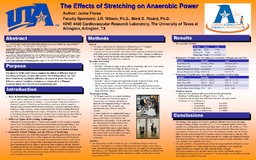
ATTENTION: The works hosted here are being migrated to a new repository that will consolidate resources, improve discoverability, and better show UTA's research impact on the global community. We will update authors as the migration progresses. Please see MavMatrix for more information.
Show simple item record
| dc.contributor.author | Flores, Jaime | |
| dc.date.accessioned | 2017-04-06T22:13:57Z | |
| dc.date.available | 2017-04-06T22:13:57Z | |
| dc.date.issued | 2014 | |
| dc.identifier.uri | http://hdl.handle.net/10106/26525 | |
| dc.description | KINE 4400 | en_US |
| dc.description.abstract | INTRODUCTION: Warming up prior to exercise or participating in athletic events has been considered essential in preventing injury. The most debatable question among athletes and the general population alike is what type of warm-up to do and which is either beneficial or detrimental to performance. Research has shown that performing a dynamic warm-up prior to exercise has improved performance in power compared to static stretching.
PURPOSE: The purpose of the study was to examine the effects of different types of stretching techniques on anaerobic power.
METHODS: Six college males (mean ±SD: age, 23.33 ±1.11 years; height, 179.48 ±4.78 cm; weight, 83.80 ±7.24 kg) volunteered to participate in the study. Each subject signed an informed consent document and filled out demographic information prior to testing. The participants were tested for six visits with at least 24 hours of rest in between each. Each performed a Wingate Anaerobic Test (WAnT) during the first three visits and a vertical jump test (VJ) during the last three. A practice WAnT and VJ were assigned prior to applying stretching intervention for familiarization with each test. Half of the subjects were randomly assigned to perform a dynamic warm-up (Dy) prior to the second WAnT and VJ. The other half performed the static routine (St) on the final visit of each performance test. Each routine focused on the major muscle groups of the lower body including the quads, hamstrings, gluteal, and calf muscles. The static routine consisted of 7 stretches, held for 20 seconds for 2 times per leg while the dynamic routine consisted of 7 exercises routines performed for 1 lap of 40 feet. Data analysis was performed using Excel 2010. The alpha level for significance was set at p ≤ 0.05.
RESULTS: The variables analyzed (mean ±SD) for each routine (Dy & St) on the WAnT were as follows: Peak Power (Dy: 1274.83 ±130.64 W, St: 1180.83 ±166.47 W), Mean Power (Dy: 584.50 ±86.60 W, St: 574.83 ±97.38 W), Relative Peak Power (Dy: 15.22 ±0.93 W/kg, St: 14.10 ±1.57 W/kg), and Relative Mean Power (Dy: 6.94 ±0.54 W/kg, St: 6.83 ±0.77 W/kg). The variables analyzed (mean ±SD) for each routine (Dy & St) on the VJ were as follows: Peak Power (Dy: 8546.71 ±524.88 W, St: 8254.10 ±511.47 W), Mean Power (Dy: 1804.32 ±224.89 W, St: 1704.10 ±213.29 W), Relative Peak Power (Dy: 102.54 ±8.70 W/kg, St: 99.09 ±9.16 W/kg), and Relative Mean Power (Dy: 21.53 ±1.98 W/kg, St: 20.35 ±2.04 W/kg). There was no significant difference between the stretching techniques in each variable (p>0.05) on the WAnT. There was a significant difference in the variables between the stretching techniques on the VJ (PP: p=0.0003, MP: p=0.0003, rPP: p=0.00007, rMP: p=0.00007).
CONCLUSION: The results of this study indicated that performing a dynamic routine yields greater power output on a vertical jump than a static routine, but has no significant difference in a Wingate Anaerobic Test. A dynamic warm-up improves performance on exercise bouts of 1-3 seconds but not on maximal anaerobic tests of 30 seconds. | en_US |
| dc.description.sponsorship | Faculty Sponsor J.R. Wilson | en_US |
| dc.description.sponsorship | Faculty Sponsor Mark D. Ricard | en_us |
| dc.language.iso | en_US | en_US |
| dc.subject | stretching techniques | en_US |
| dc.subject | Wingate anaerobic test | en_US |
| dc.subject | vertical jump test | en_US |
| dc.title | The Effects of Stretching on Anaerobic Power | en_US |
| dc.type | Presentation | en_US |
| dc.publisher.department | Department of Kinesiology, The University of Texas at Arlington | en_us |
| dc.publisher.department | Cardiovascular Research Laboratory, The University of Texas at Arlington | en_us |
| dc.publisher.department | Exercise Science Research Laboratories, The University of Texas at Arlington | en_us |
Files in this item
- Name:
- Flores J.pdf
- Size:
- 689.7Kb
- Format:
- PDF
- Description:
- pdf
This item appears in the following Collection(s)
Show simple item record


